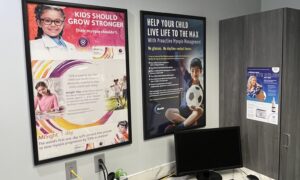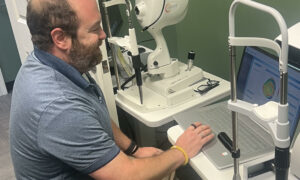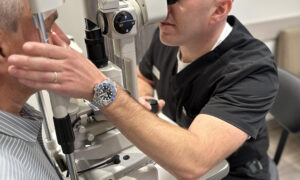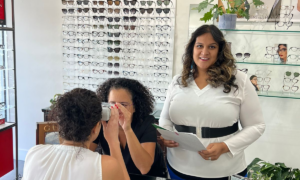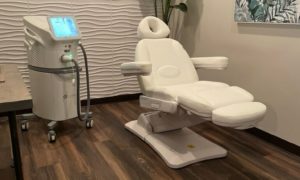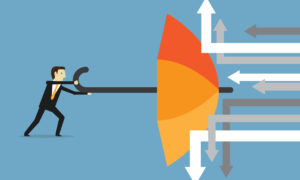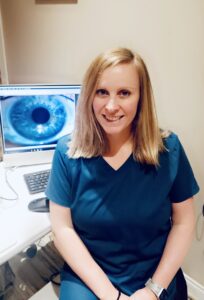
Dr. Noble with her office’s OCULUS Keratograph 5M, a topographer as well as anterior seg imaging, which Dr. Noble uses to help care for her specialty lens patients. Dr. Noble says that working with these patients gives her a chance to provide solutions to patients who often have struggled for many years to achieve optimal vision.
Growing a profitable medically necessary contact lens niche.
By Natalie Noble, OD
May 1, 2024
One of my great passions in optometry is specialty contact lenses. The patients these contacts serve often have visited multiple doctors with no solution to their visual challenges. If you are able to successfully improve their quality of life, these patients will become some of the most loyal and appreciative individuals that you’ll encounter in your career.
Here is how I work to achieve our patients’ goals, as well as the goals of the practice.
Is There Enough Patient Volume for a Focus on Medically Necessary Contacts?
At least 60 percent of my weekly schedule is taken up by specialty contacts and corneal disease. The remainder is made up of ocular surface disease patients in other forms of treatment, along with a small number of primary medical eyecare patients.
Patients who require medically necessary contacts suffer from corneal diseases such as keratoconus, post-LASIK ectasia, corneal transplants, corneal scarring and other degenerations or trauma that lead to irregularity.
These patients have debilitating visual distortion and aberrations that glasses cannot correct. Ocular surface disease patients are also a subset that benefit tremendously from scleral lenses in particular to relieve chronic dryness and associated pain and visual decline.
Reimbursement varies widely based on lens type, diagnoses, severity and insurance coverage. When assessing profitability in your practice for fitting medically necessary contacts, the following should be considered: lens fees, lab policies for remakes, chair time, staff time, reimbursements for lenses and fit as well as office visits and clinically relevant imaging.
Every insurance plan, vision or medical, has their own requirements for medically necessary coding and submission. Over the years, we have become exceedingly familiar with the nuances of each plan so that we can properly submit the correct forms and documentation to avoid claim denials.
Create a Process for Getting Needed Insurance Information from Patients
When a new patient is referred to our office for medically necessary contacts, our staff gathers all vision and medical insurance information over the phone to assess if they might have full or partial coverage. If a known diagnosis is available, the patient is informed about what coverage they have prior to their appointment.
At the date of service, diagnosis and lens type is confirmed and we submit the claim the same day for the fit and lens order. The lenses are ordered during the initial visit, as our rate of denials is very low, and we try to avoid delaying the process of getting the patients into their new lenses.
Other Articles to Explore
Train Your Staff to Support Your Work with Medically Necessary CL Patients
All of our staff are well versed in educating patients about potential insurance coverage so that the patient has full transparency and understanding of what they may owe out of pocket on day one.
Assigning specific employees to focus on the medically necessary billing process allows for improved results and fewer denials.
Doctors in the office also must gain knowledge of proper coding and documentation to support each submission. Staff training and updates occur in our office regularly as insurance plan requirements and processes change.
We also provide periodic educational meetings for staff with updates on lens designs, treatments and products that we will be offering our patients. Staff thrive on education and understanding the why behind the specific imaging and the decision-making process for lens selection.
This education allows them to better field questions from patients about solutions, lens care and alternative options and general expectations.
A well-informed staff gives the added benefits of staff retention and job satisfaction, which translates to improved patient experience and outcomes.
Continue Learning Yourself, Too, About Medically Necessary Contacts
Gaining in-depth knowledge of the underlying disease processes is vital to being a successful contact lens specialist. I would recommend following and attending meetings with International Keratoconus Academy (IKA), International Congress of Scleral Contacts (ICSC) and Global Specialty Lens Symposium (GSLS), as well as learning from publications and education by GP Lens Institute (GPLI) and Scleral Lens Education Society (SLES), to name just a few key resources.
Meeting with like-minded professionals, and adapting best practices from knowledgeable peers, is the absolute best way to advance your own skills and approach to patient care.
Create a Schedule that Accommodates Medically Necessary CL Patients for Improved Efficiency
We created a specific scheduling template to allow for many specialty lens visits in the same day. Realistically, most practices don’t have multiples of advanced imaging equipment, so we must stagger the schedule to avoid requiring the same equipment for several patients at the same time.
Our technicians have been trained in exam type protocols so that when a new fit or follow-up is started, they perform a consistent set of diagnostics and imaging to maximize efficiency and reduce chair time.
One of the adaptations we embraced over time is the training of a “specialized” staff, from patient care coordination to advanced contact lens technicians to billing specialists. Appropriate staff support in a high-volume medically necessary contacts lens practice is vital.
What Instruments Do I Need to Care for Medically Necessary CL Patients?
Scleral profilometry emerged in recent years as a spectacular advancement in scleral lens fitting.
I use the Eaglet Scleral Profilometer (ESP). It has proved to be invaluable in reducing chair time and lens adjustments, therefore maximizing revenue as well as the patient’s experience. The fee to the patient is included in their initial fitting process imaging fees.
The other valuable technology is anterior segment photography and OCT imaging. We image lenses at every follow-up for fitting analysis, comparison and patient education. We use the OCULUS Keratograph 5M and ZEISS Cirrus HD-OCT 5000.
Achieve a High Degree of Professional Fulfillment
Specializing in medically necessary contact lenses continues to be a privilege in my career. Having the opportunity to care for this patient base with such a critical need for visual improvement is both humbling and rewarding.
It is truly an honor to be able to provide sight for those in need.
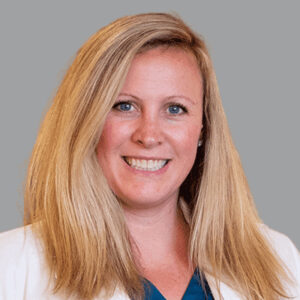 Natalie Noble, OD, practices at Noble Vision Center, now a part of AEG Vision, in Greensburg, Penn. To contact her: nnoble@eyecarespecialtiespa.
Natalie Noble, OD, practices at Noble Vision Center, now a part of AEG Vision, in Greensburg, Penn. To contact her: nnoble@eyecarespecialtiespa.

